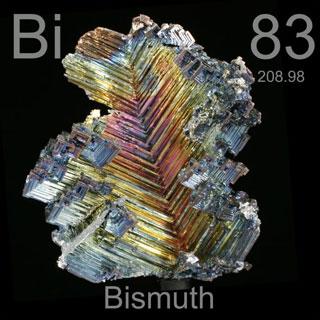|
Bismuth is a white, crystalline, brittle metal with a pinkish tinge. Bismuth is the most diamagnetic of all metals, and the thermal conductivity is lower than any metal except mercury. It has a high electrical resistance, and has the highest Hall effect of any metal (that is, the greatest increase in electrical resistance when placed in a magnetic field). Bismuth is stable to oxygen and water but dissolves in concentrated nitric air. All bismuth salts form insoluble compounds when put into water. Applications Bismuth metal is used in the manufacture of low melting solders and fusible alloys as well as low toxicity bird shot and fishing sinkers. Certain bismuth compounds are also manufactured and used as pharmaceuticals. Industry makes use of bismuth compounds as catalysts in manifacturing acrylonitrile, the starting material for synthetic fibers and rubbers. Bismuth is sometimes used in the production of shot and shotguns. |
